Foodshed as an Example of Preliminary Research for Conducting Environmental Carrying Capacity Analysis
Abstract
1. Introduction
2. Materials and Methods
2.1. Study Area
2.2. Analysis Database
2.3. Determining the Framework of Data Analysis
2.4. Determining a Framework of Foodshed Assessment
3. Results
3.1. Data Analysis Results
3.2. Foodshed Boundary Determination
4. Discussion
5. Conclusions
Acknowledgments
Author Contributions
Conflicts of Interest
References
- U’Thant, S. Report of Secretary-General UN on May 26, 1969, Problems of the Human Environment; United Nation, Economic and Social Council: New York, NY, USA, 1969. [Google Scholar]
- Edelman, D.J. Carrying Capacity Based Regional Planning. Available online: https://repub.eur.nl/pub/32680 (accessed on 20 March 2018).
- United Nations Environment Programme. Global Environment Outlook 5; United Nations Environment Programme: Nairobi, Kenya, 2014. [Google Scholar]
- Izakovičová, Z.; Mederly, P.; Petrovič, F. Long-Term Land Use Changes Driven by Urbanisation and Their Environmental Effects (Example of Trnava City, Slovakia). Sustainability 2017, 9, 1553. [Google Scholar] [CrossRef]
- Hełdak, M.; Płuciennik, M. Costs of Urbanisation in Poland, Based on the Example of Wrocław. IOP Conf. Ser. Mater. Sci. Eng. 2017, 245, 72003. [Google Scholar] [CrossRef]
- Folke, C.; Jansson, A.; Larsson, J.; Costanza, R. Ecosystem Appropriation by Cities. Ambio 1997, 26, 167–172. [Google Scholar]
- Rothwell, A.; Ridoutt, B.; Page, G.; Bellotti, W. Feeding and housing the urban population: Environmental impacts at the peri-urban interface under different land-use scenarios. Land Use Policy 2015, 48, 377–388. [Google Scholar] [CrossRef]
- McPhearson, T.; Pickett, S.T.A.; Grimm, N.B.; Niemelä, J.; Alberti, M.; Elmqvist, T.; Weber, C.; Haase, D.; Breuste, J.; Qureshi, S. Advancing Urban Ecology toward a Science of Cities. Bioscience 2016, 66, 198–212. [Google Scholar] [CrossRef]
- Heldak, M.; Szczepanski, J.; Pluciennik, M.; Stacherzak, A. Planning decisions in landslide areas. J. Ecol. Eng. 2016, 17, 218–227. [Google Scholar] [CrossRef]
- Dubbeling, M.; Carey, J.; Hochberg, K. The Role of Private Sector in City Region Food Systems. Analysis Report; RUAF Foundation: Leusden, The Netherlands, 2016. [Google Scholar]
- United Nations. Draft Outcome Document of the United Nations Summit for the Adoption of the Post-2015 Development Agenda; United Nations: New York, NY, USA, 2015. [Google Scholar]
- Liu, R.Z.; Borthwick, A.G.L. Measurement and assessment of carrying capacity of the environment in Ningbo, China. J. Environ. Manag. 2011, 92, 2047–2053. [Google Scholar] [CrossRef] [PubMed]
- Fogel, P. Opracowanie Kryteriów Chłonności Ekologicznej dla Potrzeb Planowania Przestrzennego Raport Końcowy. Instytut Gospodarki Przestrzennej i Mieszkalnictwa (Development of Ecological Absorption Criteria for Spatial Planning. The Final Report. Institute of Spatial Management and Housing); Instytut Gospodarki Przestrzennej i Mieszkalnictwa [Institute of Spatial Management and Housing]: Warszawa, Poland, 2005.
- Santoso, E.B.; Erli, H.K.D.M.; Aulia, B.U.; Ghozali, A. Concept of Carrying Capacity: Challenges in Spatial Planning (Case Study of East Java Province, Indonesia). Procedia Soc. Behav. Sci. 2014, 135, 130–135. [Google Scholar] [CrossRef]
- Wei, Y.; Huang, C.; Lam, P.; Sha, Y.; Feng, Y. Using Urban-Carrying Capacity as a Benchmark for Sustainable Urban Development: An Empirical Study of Beijing. Sustainability 2015, 7, 3244–3268. [Google Scholar] [CrossRef]
- Watson, V. “The planned city sweeps the poor away…”: Urban planning and 21st century urbanisation. Prog. Plan. 2009, 72, 151–193. [Google Scholar] [CrossRef]
- Broere, W. Urban underground space: Solving the problems of today’s cities. Tunn. Undergr. Space Technol. 2016, 55, 245–248. [Google Scholar] [CrossRef]
- Solecka, I.; Sylla, M.; Świąder, M. Urban Sprawl Impact on Farmland Conversion in Suburban Area of Wroclaw, Poland. IOP Conf. Ser. Mater. Sci. Eng. 2017, 245, 72002. [Google Scholar] [CrossRef]
- Cohen, B. Urbanization in developing countries: Current trends, future projections, and key challenges for sustainability. Technol. Soc. 2006, 28, 63–80. [Google Scholar] [CrossRef]
- Carter, J.G.; Cavan, G.; Connelly, A.; Guy, S.; Handley, J.; Kazmierczak, A. Climate change and the city: Building capacity for urban adaptation. Prog. Plan. 2015, 95, 1–66. [Google Scholar] [CrossRef]
- Seidl, I.; Tisdell, C.A. Carrying capacity reconsidered: From Malthus’ population theory to cultural carrying capacity. Ecol. Econ. 1999, 31, 395–408. [Google Scholar] [CrossRef]
- Belčáková, I.; Diviaková, A.; Belaňová, E. Ecological Footprint in relation to Climate Change Strategy in Cities. IOP Conf. Ser. Mater. Sci. Eng. 2017, 245. [Google Scholar] [CrossRef]
- Rees, W.E. Ecological footprints and appropriated carrying capacity: What urban economics leaves out. Environ. Urban. 1992, 4, 121–130. [Google Scholar] [CrossRef]
- Sali, G.; Corsi, S.; Mazzocchi, C.; Monaco, F.; Wascher, D.; Van Eupen, M.; Zasada, I. FoodMetres Analysis of Food Demand and Supply in the Metropolitan Region. Available online: http://www.foodmetres.eu/wp-content/uploads/2014/05/D2.1-Analysis-of-food-demand-and-supply.pdf (accessed on 19 March 2018).
- Monfreda, C.; Wackernagel, M.; Deumling, D. Establishing national natural capital accounts based on detailed Ecological Footprint and biological capacity assessments. Land Use Policy 2004, 21, 231–246. [Google Scholar] [CrossRef]
- Wackernagel, M.; Monfreda, C.; Moran, D.; Wermer, P.; Goldfinger, S.; Deumling, D.; Murray, M. National Footprint and Biocapacity Accounts 2005: The Underlying Calculation Method; Global Footprint Network: Oakland, CA, USA, 2005. [Google Scholar]
- Moran, D.D.; Wackernagel, M.; Kitzes, J.A.; Goldfinger, S.H.; Boutaud, A. Measuring sustainable development—Nation by nation. Ecol. Econ. 2008, 64, 470–474. [Google Scholar] [CrossRef]
- Niccolucci, V.; Tiezzi, E.; Pulselli, F.M.; Capineri, C. Biocapacity vs. Ecological Footprint of world regions: A geopolitical interpretation. Ecol. Indic. 2012, 16, 23–30. [Google Scholar] [CrossRef]
- Budihardjo, S.; Hadi, S.P.; Sutikno, S.; Purwanto, P.; Al, E.T. The Ecological Footprint Analysis for Assessing Carrying Capacity of Industrial Zone in Semarang. J. Hum. Resour. Sustain. Stud. 2013, 2013, 14–20. [Google Scholar] [CrossRef]
- Galli, A. On the rationale and policy usefulness of ecological footprint accounting: The case of Morocco. Environ. Sci. Policy 2015, 48, 210–224. [Google Scholar] [CrossRef]
- Baabou, W.; Grunewald, N.; Ouellet-Plamondon, C.; Gressot, M.; Galli, A. The Ecological Footprint of Mediterranean cities: Awareness creation and policy implications. Environ. Sci. Policy 2017, 69, 94–104. [Google Scholar] [CrossRef]
- Wackernagel, M.; Rees, W. Our Ecological Footprint: Reducing Human Impact on the Earth; New Society Publisher: Gabriola Island, BC, Canada, 1998. [Google Scholar]
- Karg, H.; Drechsel, P.; Akoto-Danso, E.; Glaser, R.; Nyarko, G.; Buerkert, A. Foodsheds and City Region Food Systems in Two West African Cities. Sustainability 2016, 8, 1175. [Google Scholar] [CrossRef]
- Zasada, I.; Schmutz, U.; Wascher, D.; Kneafsey, M.; Corsi, S.; Mazzocchi, C.; Monaco, F.; Boyce, P.; Doernberg, A.; Sali, G.; et al. Food beyond the city—Analysing foodsheds and self-sufficiency for different food system scenarios in European metropolitan regions. City Cult. Soc. 2017. [Google Scholar] [CrossRef]
- Blum-Evitts, S. Designing a Foodshed Assessment Model: Guidance for Local and Regional Planners in Understanding Local Farm Capacity in Comparison to Local Food Needs; University of Massachusetts Amherst: Amherst, MA, USA, 2009. [Google Scholar]
- De Zeeuw, H.; Dubbeling, M. Process and tools for multi-stakeholder planning of the urban agro-food system. In Cities and Agriculture—Developing Resilient Urban Food Systems; de Zeeuw, H., Drechsel, P., Eds.; Routledge: Abingdon, UK, 2015; pp. 56–87. ISBN 9781315716312. [Google Scholar]
- Butler, M. Analyzing the Foodshed: Toward a More Comprehensive Foodshed Analysis. Master’s Thesis, Portland State University, Portland, OR, USA, 2013. [Google Scholar]
- Chen, S. Civic Agriculture: Towards a Local Food Web for Sustainable Urban Development. APCBEE Procedia 2012, 1, 169–176. [Google Scholar] [CrossRef]
- Richardson, J.J.; Moskal, L.M. Urban food crop production capacity and competition with the urban forest. Urban For. Urban Green. 2016, 15, 58–64. [Google Scholar] [CrossRef]
- Sonnino, R. The cultural dynamics of urban food governance. City Cult. Soc. 2017. [Google Scholar] [CrossRef]
- Moustier, P.; Renting, H. Urban agriculture and short chain food marketing in developing countries. In Cities and Agriculture—Developing Resilient Urban Food Systems; de Zeeuw, H., Drechsel, P., Eds.; Earthscan Publications Ltd.: London, UK, 2015; pp. 121–138. [Google Scholar]
- Saha, M.; Eckelman, M.J. Landscape and Urban Planning Growing fresh fruits and vegetables in an urban landscape: A geospatial assessment of ground level and rooftop urban agriculture potential in Boston, USA. Landsc. Urban Plan. 2017, 165, 130–141. [Google Scholar] [CrossRef]
- Moghadam, S.T.; Delmastro, C.; Lombardi, P.; Corgnati, S.P. Towards a New Integrated Spatial Decision Support System in Urban Context. Procedia Soc. Behav. Sci. 2016, 223, 974–981. [Google Scholar] [CrossRef][Green Version]
- Szewrański, S.; Kazak, J.; Żmuda, R.; Wawer, R. Indicator-Based Assessment for Soil Resource Management in the Wrocław Larger Urban Zone of Poland. Pol. J. Environ. Stud. 2017, 26, 2239–2248. [Google Scholar] [CrossRef]
- Kazak, J.K. Scenariusze Zamian Zagospodarowania Przestrzennego i Ocena ich Skutków Środowiskowych na Przykładzie Strefy Podmiejskiej Wrocławia. [Scenarios for Changes in Land Use Development and Assessment of Their Environmental Impact: The Case of the Wrocław Suburban Zone]; Uniwersytet Przyrodniczy we Wrocławiu, Wydział Inżynierii Kształtowania Środowiska i Geodezji [Wrocław University of Environmental and Life Sciences, Faculty of Environmental Engineering and Geodesy]: Wrocław, Poland, 2016. [Google Scholar]
- European Comission. The Polish Food Basket; European Comission: Brussels, Belgium, 2015. [Google Scholar]
- Szewrański, S.; Kazak, J.; Sylla, M.; Świąder, M. Spatial Data Analysis with the Use of ArcGIS and Tableau Systems; Springer: Berlin, Germany, 2017; pp. 337–349. [Google Scholar]
- Steinbach, M.; Karypis, G.; Kumar, V. A Comparison of Document Clustering Techniques. Available online: https://www.researchgate.net/publication/2628533_A_Comparison_of_Document_Clustering_Techniques (accessed on 19 March 2018).
- Motavalli, P.; Nelson, K.; Udawatta, R.; Jose, S.; Bardhan, S. Global achievements in sustainable land management. Int. Soil Water Conserv. Res. 2013, 1, 1–10. [Google Scholar] [CrossRef]
- Przybyła, K.; Kulczyk-Dynowska, A.; Kachniarz, M. Quality of Life in the Regional Capitals of Poland. J. Econ. Issues 2014, 48, 181–196. [Google Scholar] [CrossRef]
- Isman, M.; Archambault, M.; Racette, P.; Konga, C.N.; Llaque, R.M.; Lin, D.; Iha, K.; Ouellet-Plamondon, C.M. Ecological Footprint assessment for targeting climate change mitigation in cities: A case study of 15 Canadian cities according to census metropolitan areas. J. Clean. Prod. 2018, 174, 1032–1043. [Google Scholar] [CrossRef]
- Bouma, J. Land quality indicators of sustainable land management across scales. Agric. Ecosyst. Environ. 2002, 88, 129–136. [Google Scholar] [CrossRef]
- Tokarczyk-Dorociak, K.; Kazak, J.; Szewrański, S. The Impact of a Large City on Land Use in Suburban Area—The Case of Wrocław (Poland). J. Ecol. Eng. 2018, 19, 89–98. [Google Scholar] [CrossRef]
- Dabek, P.; Zmuda, R.; Cmielewski, B.; Szczepanski, J. Analysis of water erosion processes using terrestrial laser scanning. ACTA Geodyn. Geomater. 2014, 11, 45–52. [Google Scholar] [CrossRef]
- Galli, A.; Halle, M.; Grunewald, N. Physical limits to resource access and utilisation and their economic implications in Mediterranean economies. Environ. Sci. Policy 2015, 51, 125–136. [Google Scholar] [CrossRef]
- Fraser, E.D.G.; Dougill, A.J.; Mabee, W.E.; Reed, M.; McAlpine, P. Bottom up and top down: Analysis of participatory processes for sustainability indicator identification as a pathway to community empowerment and sustainable environmental management. J. Environ. Manag. 2006, 78, 114–127. [Google Scholar] [CrossRef] [PubMed]
- DuPuis, E.M.; Goodman, D. Should we go “home” to eat? Toward a reflexive politics of localism. J. Rural Stud. 2005, 21, 359–371. [Google Scholar] [CrossRef]
- Donald, B.; Gertler, M.; Gray, M.; Lobao, L. Re-regionalizing the food system? Camb. J. Reg. Econ. Soc. 2010, 3, 171–175. [Google Scholar] [CrossRef]
- Bellows, A.C.; Hamm, M.W. Local autonomy and sustainable development: Testing import substitution in more localized food systems. Agric. Hum. Values 2001, 18, 271–284. [Google Scholar] [CrossRef]
- Peters, C.J.; Bills, N.L.; Lembo, A.J.; Wilkins, J.L.; Fick, G.W. Mapping potential foodsheds in New York State: A spatial model for evaluating the capacity to localize food production. Renew. Agric. Food Syst. 2009, 24, 72–84. [Google Scholar] [CrossRef]
- Lengnick, L.; Miller, M.; Marten, G.G. Metropolitan foodsheds: A resilient response to the climate change challenge? J. Environ. Stud. Sci. 2015, 5, 573–592. [Google Scholar] [CrossRef]

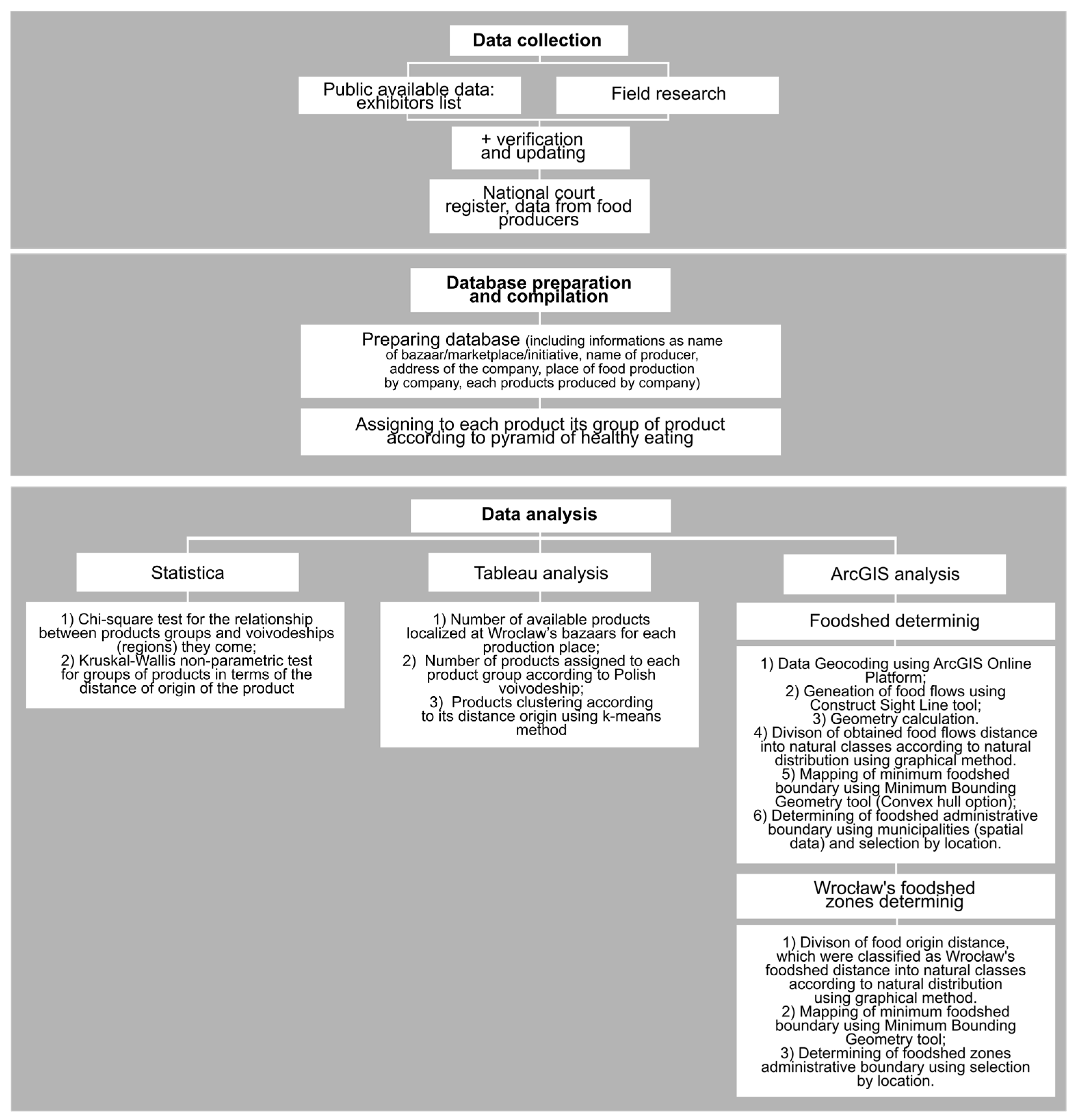
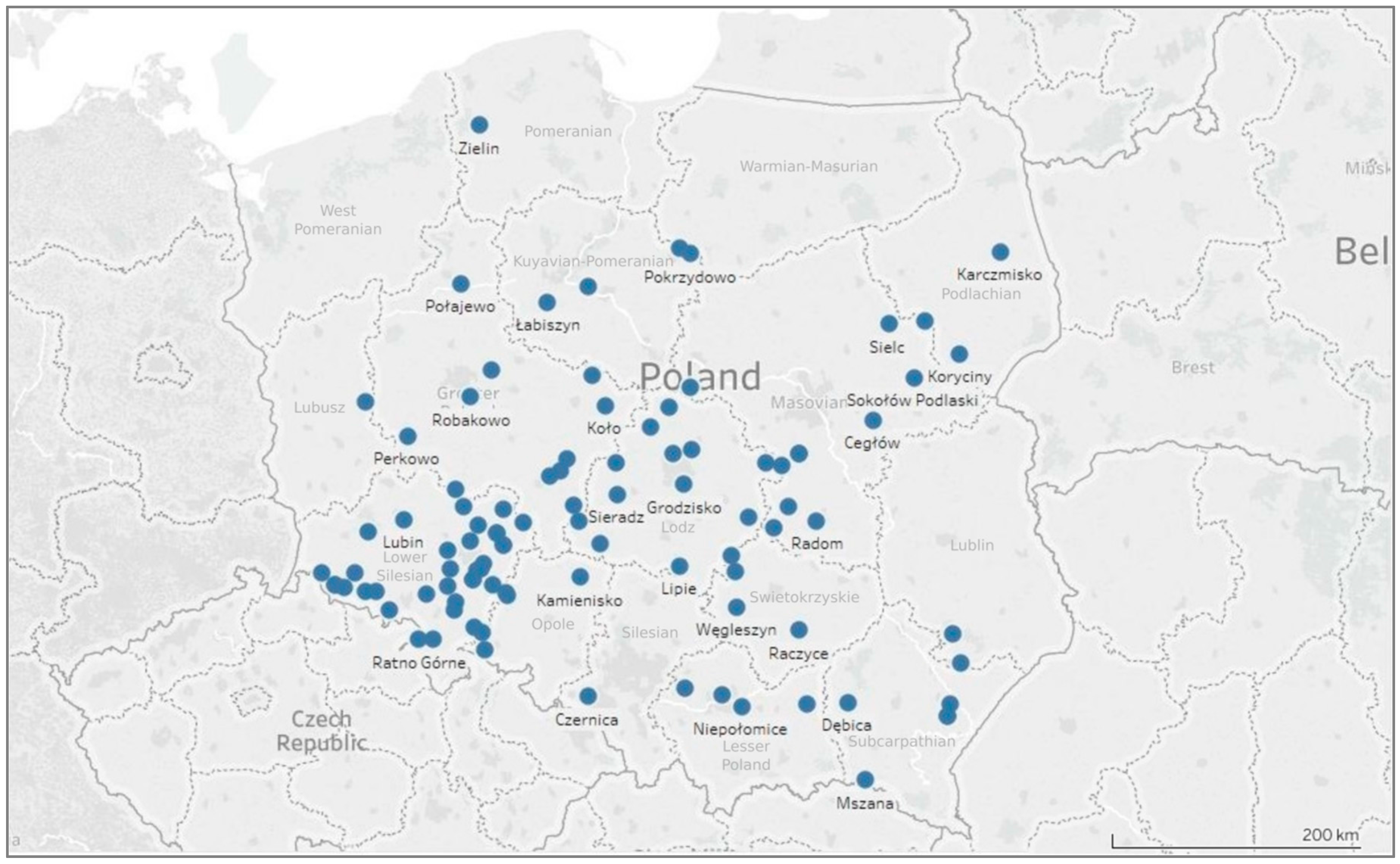
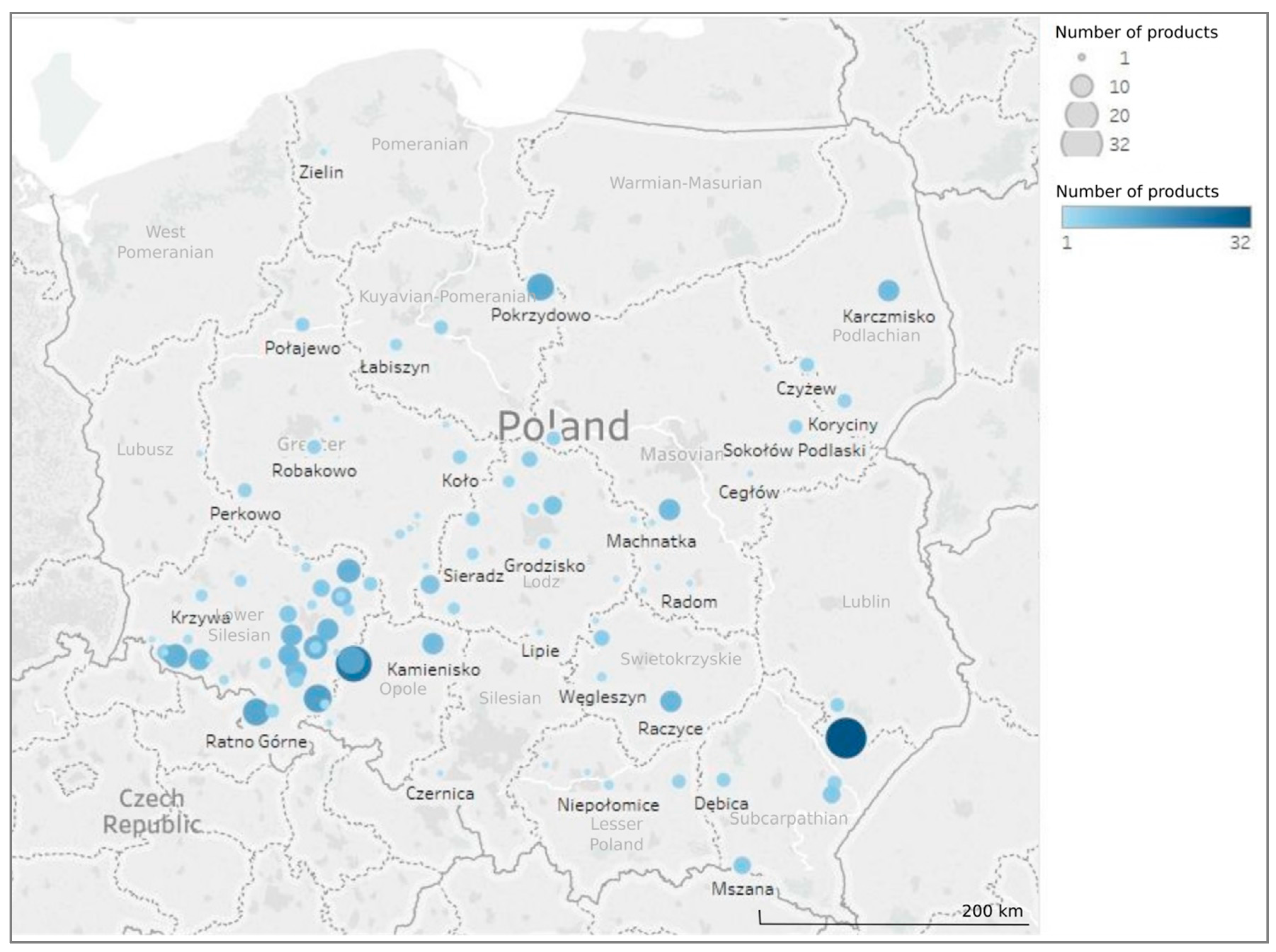
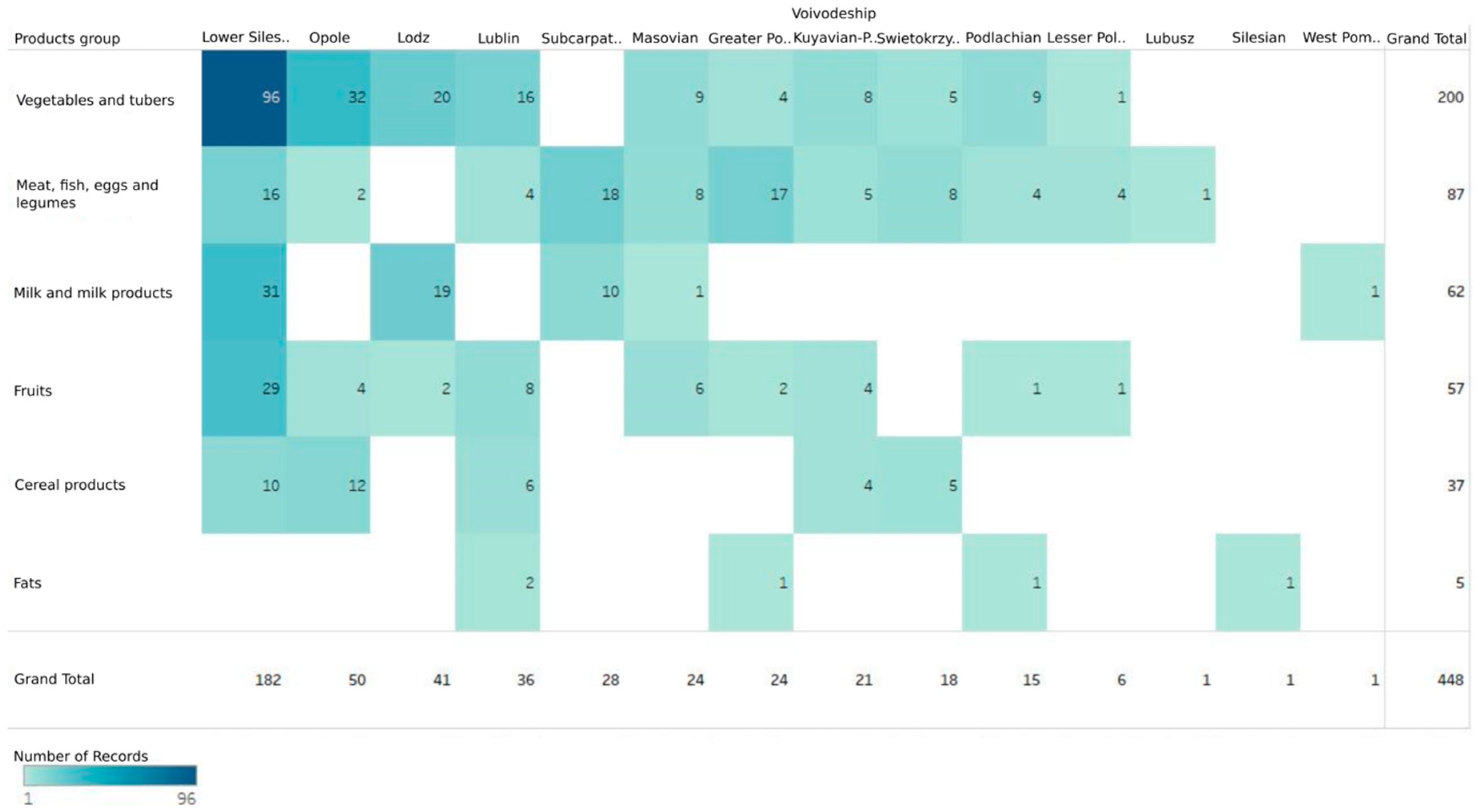
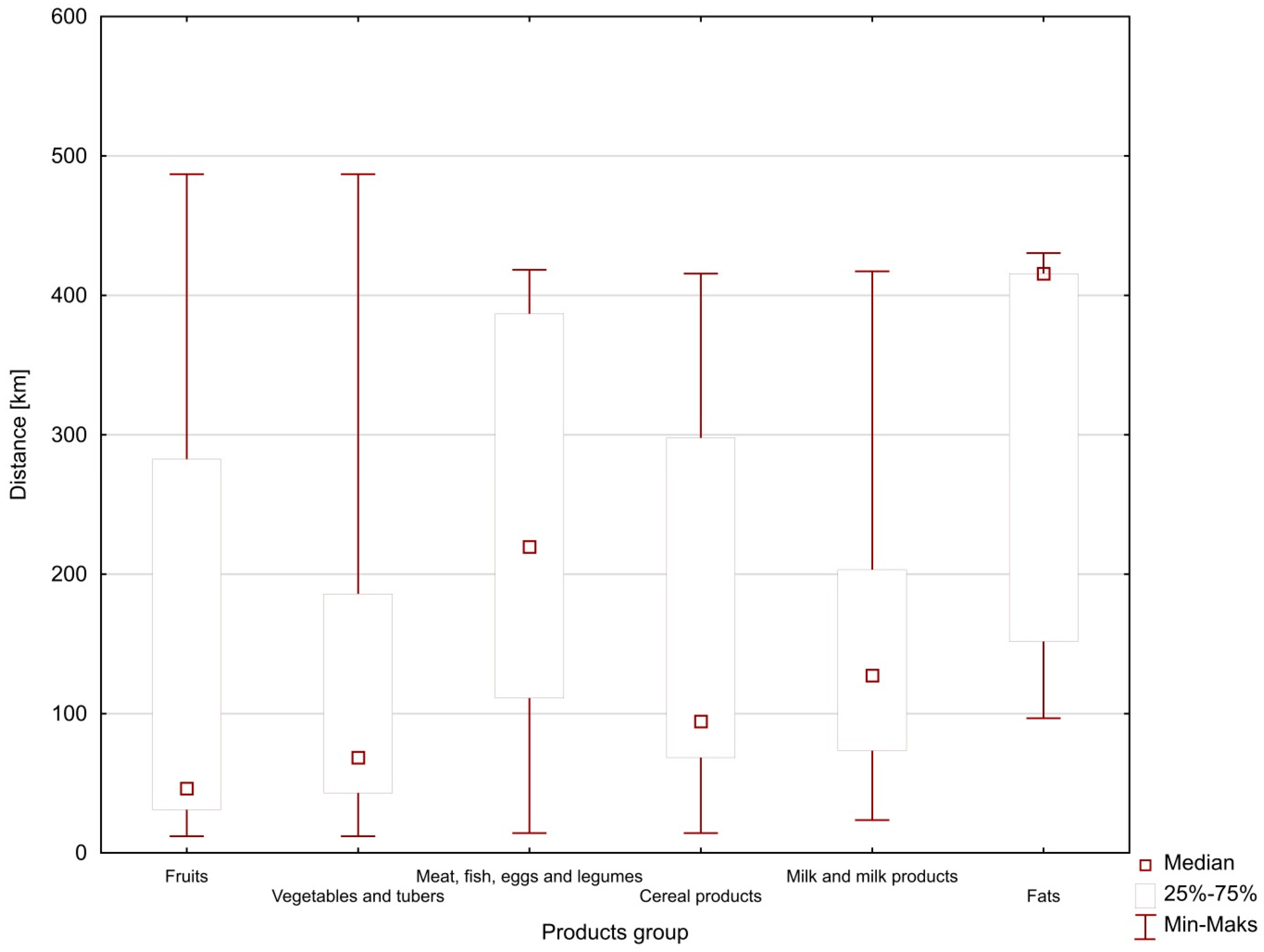
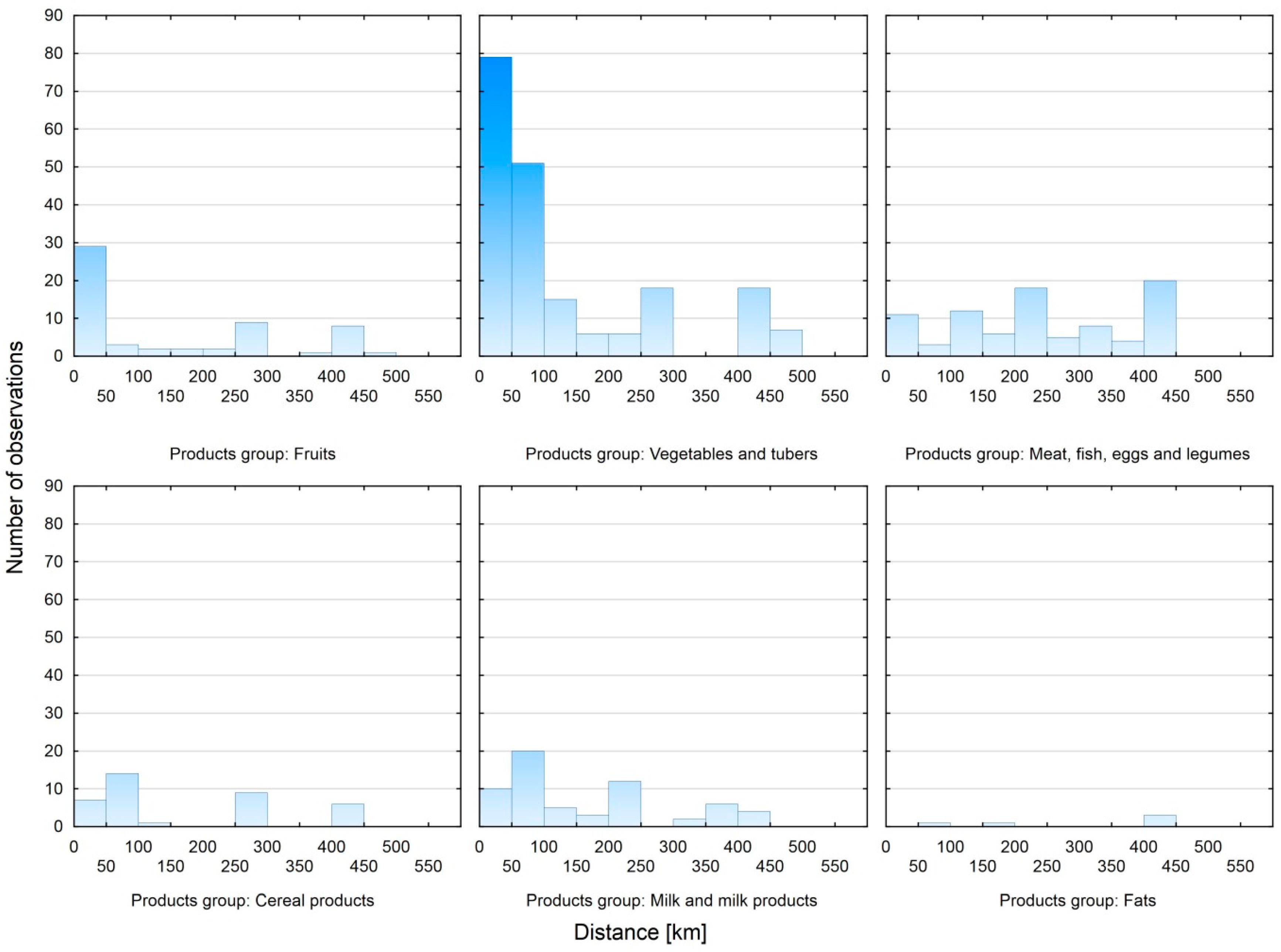



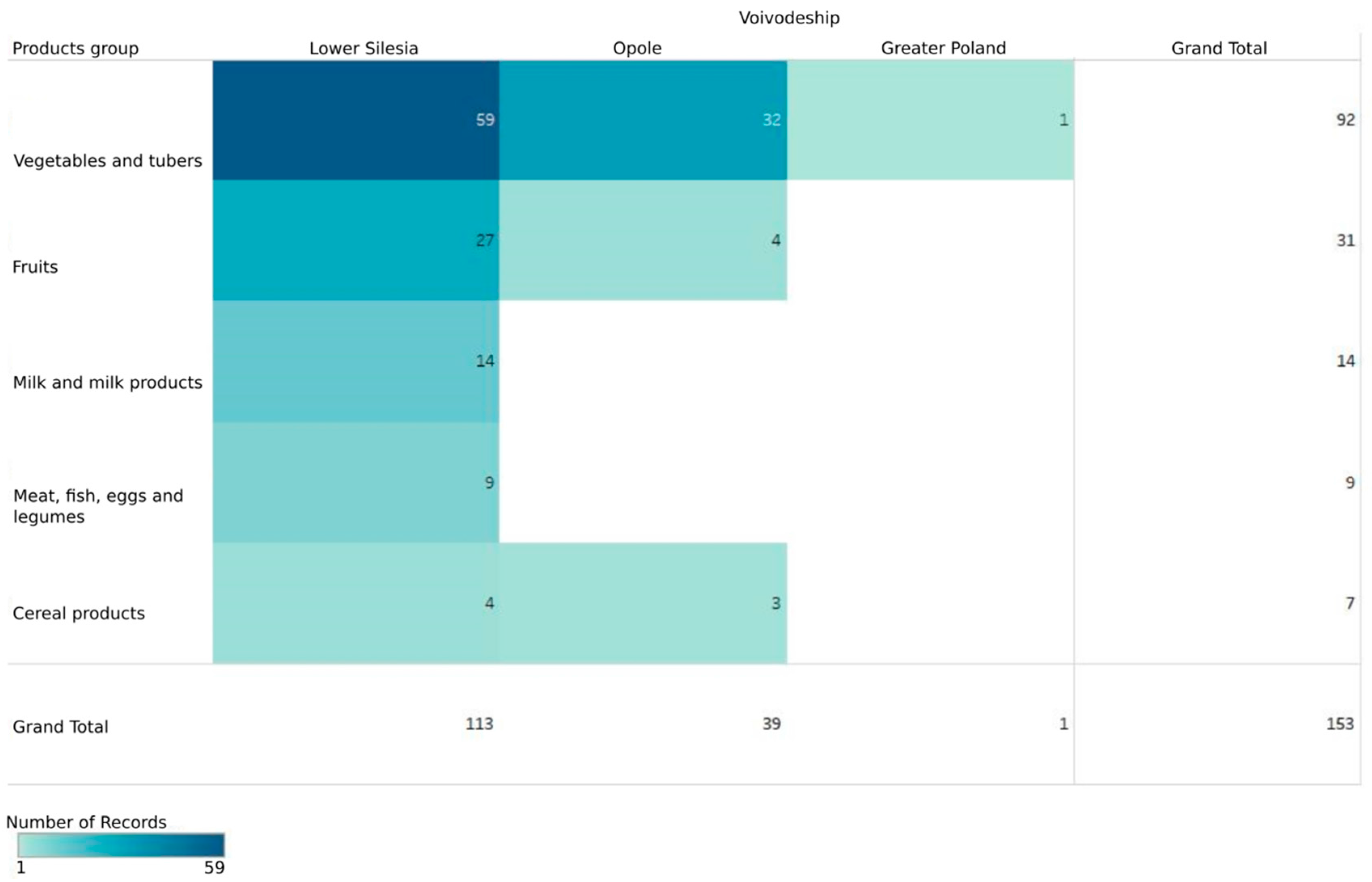
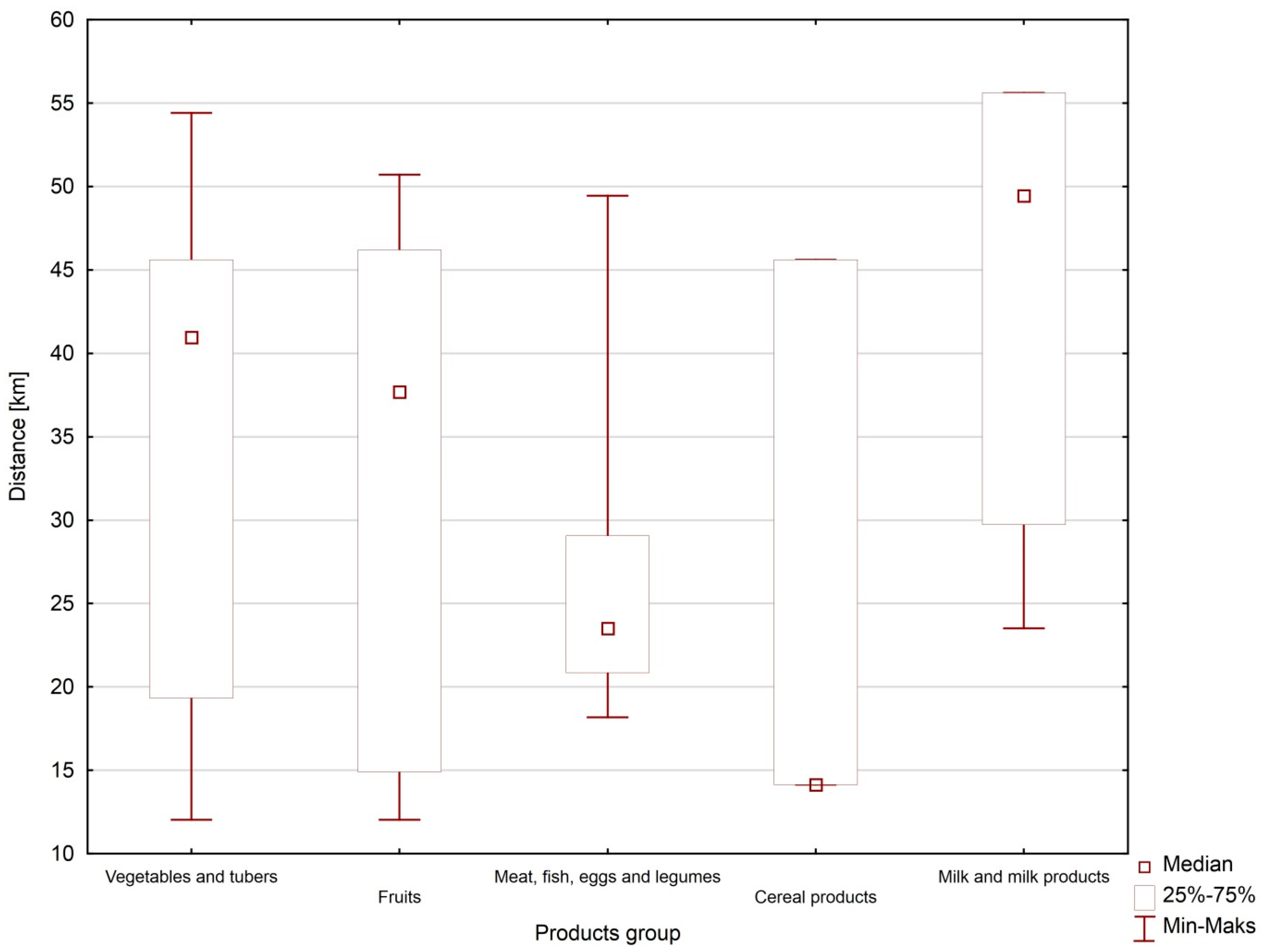
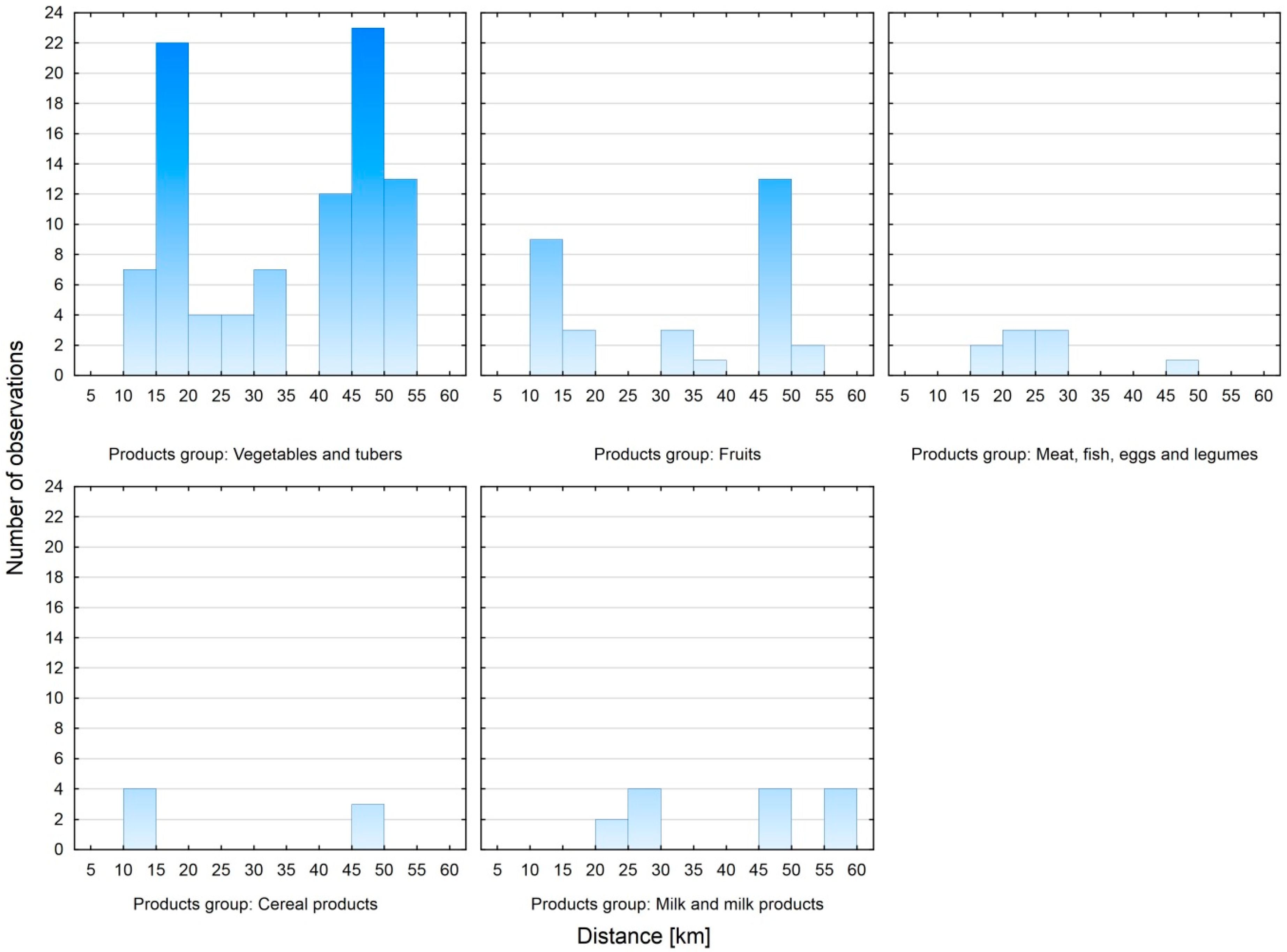
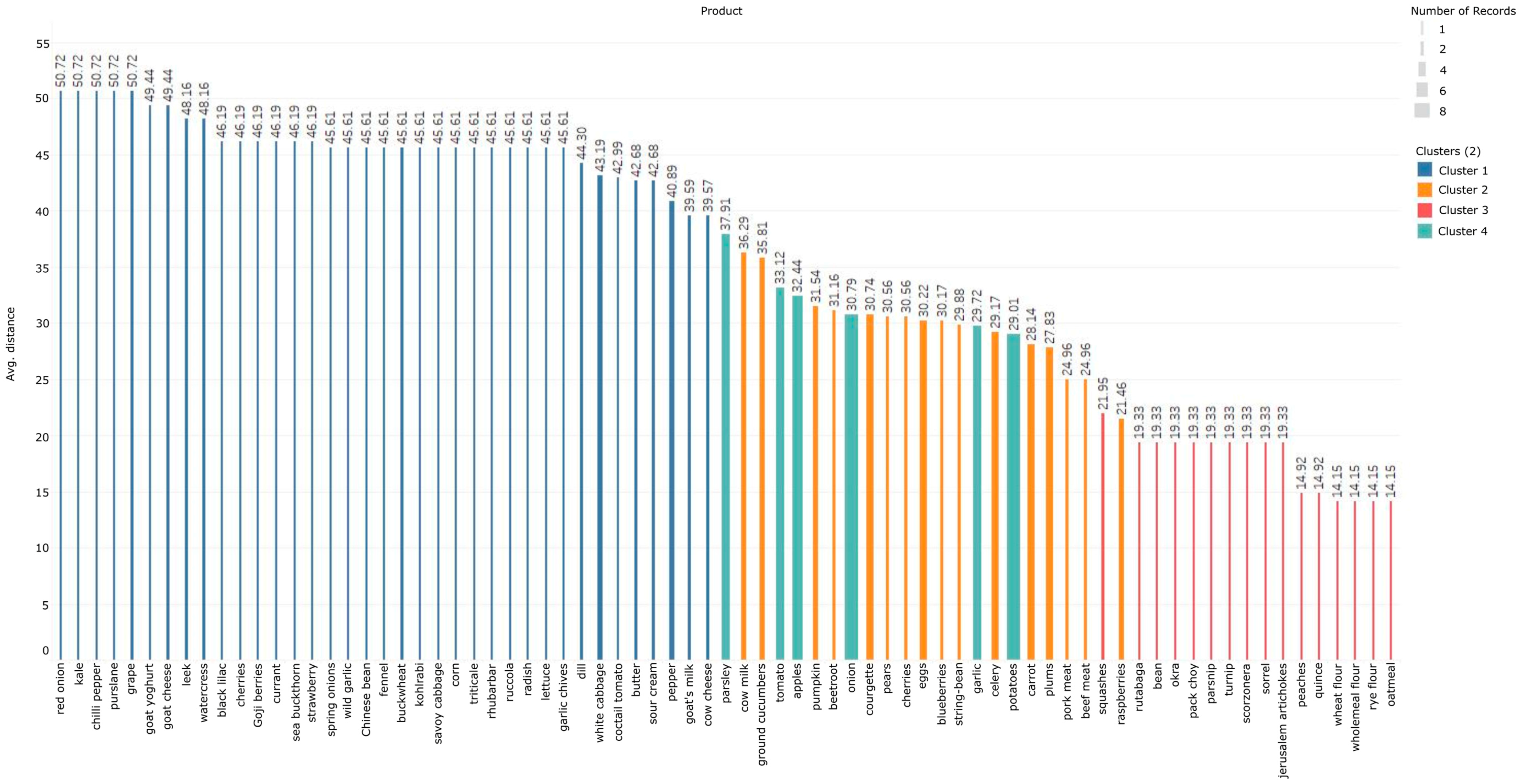
| TargPiast Marketplace | LSCAFWM | Bazaar at the Świebodzki | Market Square | Ekobazar | Bazaar ‘Krótka Droga’ | Wrocław’s Gourmets Bazaar | Local Farmer Initiative | |
|---|---|---|---|---|---|---|---|---|
| Public database/Website | x | x | x | x | x | |||
| Field research | x | x | x | x | x | |||
| Questionnaire/e-mails | x | x | x | x | x |
© 2018 by the authors. Licensee MDPI, Basel, Switzerland. This article is an open access article distributed under the terms and conditions of the Creative Commons Attribution (CC BY) license (http://creativecommons.org/licenses/by/4.0/).
Share and Cite
Świąder, M.; Szewrański, S.; Kazak, J.K. Foodshed as an Example of Preliminary Research for Conducting Environmental Carrying Capacity Analysis. Sustainability 2018, 10, 882. https://doi.org/10.3390/su10030882
Świąder M, Szewrański S, Kazak JK. Foodshed as an Example of Preliminary Research for Conducting Environmental Carrying Capacity Analysis. Sustainability. 2018; 10(3):882. https://doi.org/10.3390/su10030882
Chicago/Turabian StyleŚwiąder, Małgorzata, Szymon Szewrański, and Jan K. Kazak. 2018. "Foodshed as an Example of Preliminary Research for Conducting Environmental Carrying Capacity Analysis" Sustainability 10, no. 3: 882. https://doi.org/10.3390/su10030882
APA StyleŚwiąder, M., Szewrański, S., & Kazak, J. K. (2018). Foodshed as an Example of Preliminary Research for Conducting Environmental Carrying Capacity Analysis. Sustainability, 10(3), 882. https://doi.org/10.3390/su10030882







